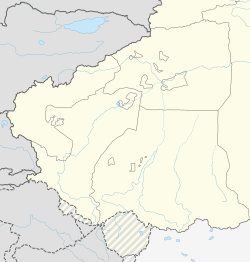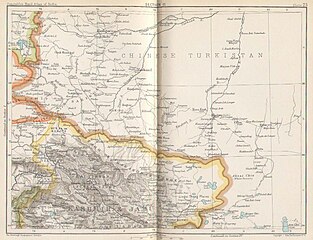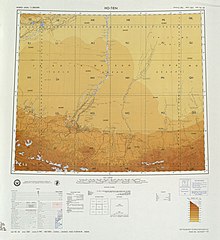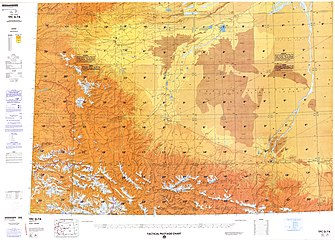| Qira County
چىرا ناھىيىسى (Uyghur) 策勒县 (Chinese)Chira, Cele, Ts'e-le | |
|---|---|
| County | |
 Location of the county in Hotan Prefecture (yellow) and Xinjiang Location of the county in Hotan Prefecture (yellow) and Xinjiang | |
   | |
| Coordinates: 37°00′N 80°48′E / 37.000°N 80.800°E / 37.000; 80.800 | |
| Country | China |
| Autonomous region | Xinjiang |
| Prefecture | Hotan |
| County seat | Qira Town |
| Township-level divisions | 2 towns, 6 townships |
| Area | |
| • Total | 31,688.01 km (12,234.81 sq mi) |
| Elevation | 1,500−7,282 m (4,900−23,981 ft) |
| Population | |
| • Total | 157,792 |
| • Density | 5.0/km (13/sq mi) |
| Ethnic groups | |
| • Major ethnic groups | Uyghur |
| Time zone | UTC+8 (China Standard) |
| Postal code | 848300 |
| Website | xjcl |
| Qira County | |||||||||||
|---|---|---|---|---|---|---|---|---|---|---|---|
| Uyghur name | |||||||||||
| Uyghur | چىرا ناھىيىسى | ||||||||||
| |||||||||||
| Chinese name | |||||||||||
| Simplified Chinese | 策勒县 | ||||||||||
| Traditional Chinese | 策勒縣 | ||||||||||
| |||||||||||
Qira County (Uyghur: چىرا ناھىيىسى), alternatively Chira or Cele (from Mandarin Chinese), is a county in Hotan Prefecture, Xinjiang Uyghur Autonomous Region, China. Almost all the residents of the county are Uyghurs and live around oases situated between the desolate Taklamakan Desert and Kunlun Mountains. The county is bordered to the north by Aksu Prefecture, to the east by Yutian / Keriya County, to the northwest by Lop County, to the southwest by Hotan County including the China-India disputed Aksai Chin area and to the south by Rutog County, Ngari Prefecture in Tibet.
History
The sixth century Dandan Oilik oasis town archaeological site where Buddhist shrines and texts were discovered is located in the desert of northern Qira (Chira) County.
Qira town (Chira), the town that is the current county seat of Qira County, has been forced to change locations on three occasions due to encroachment by the sands of the Taklamakan Desert.
In his 1900-01 expedition in the region, Aurel Stein travelled across the northern section of today's Qira County, a section of the Taklamakan Desert between today's Lop County and the Keriya River. There were several wells along the course he took.
Qira County was divided from Yutian / Keriya County in 1928/9.
In the thirty years between the 1950s and 1980s, a significant area of farmland near the county seat was taken into the desert by blown sand.
Since the founding of Xinjiang Autonomous Region in 1955, Qira County has been part of Hotan Prefecture.
In the 1980s, 446 households living in the county seat were forced to relocate due to the effects of desertification which had brought the Taklamakan Desert within 1.5 kilometres (0.93 mi) km of their homes, sometimes burying homes in sand overnight.
"When I woke up one morning, I found I couldn't open the door because of the weight of sand that had accumulated overnight. My crops were buried too, so I had no choice but to move" -Memet Simay, area resident
In 1983, the Qira research station of the Chinese Academy of Sciences was founded to combat drift sand. A transitional zone was established with help from the scientists at the station, and the sands were pushed back over 5 kilometres (3.1 mi).
In 2005, a small 1,500 year-old Buddhist temple was discovered 7 km (4.3 mi) from Damiku (Damagou).
On October 20, 2014, Damiku (Damagou) was changed from a township to a town.
On January 7, 2016, areas near Nur, Bostan and Ulughsay townships in Qira County were made part of the newly created Kunyu.
On February 28, 2017, it was announced by the county government that those who reported others for stitching the 'star and crescent moon' insignia on their clothing or personal items or having the words 'East Turkestan' on their mobile phone case, purse or other jewelry, would be eligible for cash payments.
In March 2017, Salamet Memetimin, the Communist Party secretary for Chaka township's Bekchan village and ethnic Uyghur, was relieved of her duties for taking her nikah marriage vows at her home. According to the Hotan Daily, 97 officials were charged with disciplinary violations at this time.
In 2018, local government authorities in the county expected to have almost 12,000 detainees in vocational camps and detention centres and some projects related to the centres outstripped budgetary limits.
According to the Chinese Government, by the end of 2018, construction of Jinnan New Village (津南新村) in Qira Town (Cele) was completed. To increase aid delivery to Xinjiang, places in Xinjiang are paired with other areas of China which can provide aid. Tianjin and Hotan are paired in this program. Through assistance from the Tianjin government, a standard football field and training center was constructed at the No. 1 Primary School in the county.
Geography
The northern part of Qira County is made up of sand dunes and ends in a straight line drawn in the Taklamakan Desert that forms part of the boundary between Hotan Prefecture and Aksu Prefecture. The area is between 1,500 m (4,900 ft) and 1,800 m (5,900 ft) above sea level.
Oasis areas occupy 2.9% of the total area of the county. The oasis areas along China National Highway 315 include the Qira County county seat area, Gulahma and Damiku. Qaka, Ulughsay, Nur, Bostan and Kunyu's small exclaves in Qira County are located close to the Kunlun Mountains.
The southern part of Qira County is mountainous with an average elevation of 3,200 m (10,500 ft) above sea level. The upper reaches of the White Jade River (Yurung Kash), which provide water for Hotan (Khotan), are found in the Kunlun Mountains of southern Qira County. Mountain passes in the area include Mandar Kol Dawan, Shalgon Dawan, Kuchkash Bulak Dawan, and Art Dawan. One of the prominent mountains in the county is Muztag (K5, Wu-lu-ko Ho Shan, Mo-shih Shan, Mu-shih Shan, Muztagh Jilga; 慕士山, 木斯山) which is 7,282 m (23,891 ft) above sea level. The meltwater from this mountain creates the Qira River (Cele River, Ts'e-lo Ho; 策勒河) which flows through Qaka into the Qira county seat.
In the mid-20th century, camping grounds in the sparsely populated southern mountainous area of the county included Chotma, Yangi kan, Zaiuk, Yaskako Tagh, Mandar Chap, and Chumik.
Climate
| Climate data for Qira, elevation 1,337 m (4,386 ft), (1991–2020 normals, extremes 1981–2010) | |||||||||||||
|---|---|---|---|---|---|---|---|---|---|---|---|---|---|
| Month | Jan | Feb | Mar | Apr | May | Jun | Jul | Aug | Sep | Oct | Nov | Dec | Year |
| Record high °C (°F) | 20.0 (68.0) |
23.7 (74.7) |
32.3 (90.1) |
36.9 (98.4) |
38.0 (100.4) |
40.5 (104.9) |
42.0 (107.6) |
40.9 (105.6) |
36.8 (98.2) |
32.1 (89.8) |
25.1 (77.2) |
19.6 (67.3) |
42.0 (107.6) |
| Mean daily maximum °C (°F) | 1.8 (35.2) |
8.0 (46.4) |
17.4 (63.3) |
25.0 (77.0) |
29.1 (84.4) |
32.1 (89.8) |
33.7 (92.7) |
32.5 (90.5) |
28.5 (83.3) |
21.8 (71.2) |
12.6 (54.7) |
3.9 (39.0) |
20.5 (69.0) |
| Daily mean °C (°F) | −4.4 (24.1) |
1.5 (34.7) |
10.4 (50.7) |
17.4 (63.3) |
21.5 (70.7) |
24.7 (76.5) |
26.1 (79.0) |
24.9 (76.8) |
20.4 (68.7) |
12.6 (54.7) |
4.6 (40.3) |
−2.5 (27.5) |
13.1 (55.6) |
| Mean daily minimum °C (°F) | −9.5 (14.9) |
−4.4 (24.1) |
3.6 (38.5) |
10.2 (50.4) |
14.5 (58.1) |
18.1 (64.6) |
19.8 (67.6) |
18.7 (65.7) |
13.5 (56.3) |
5.1 (41.2) |
−1.6 (29.1) |
−7.4 (18.7) |
6.7 (44.1) |
| Record low °C (°F) | −21.8 (−7.2) |
−20.7 (−5.3) |
−9.3 (15.3) |
−0.7 (30.7) |
2.6 (36.7) |
8.0 (46.4) |
11.5 (52.7) |
7.4 (45.3) |
1.9 (35.4) |
−4.7 (23.5) |
−13.7 (7.3) |
−20.5 (−4.9) |
−21.8 (−7.2) |
| Average precipitation mm (inches) | 1.3 (0.05) |
1.5 (0.06) |
2.3 (0.09) |
4.8 (0.19) |
8.4 (0.33) |
10.5 (0.41) |
7.7 (0.30) |
3.7 (0.15) |
6.9 (0.27) |
0.5 (0.02) |
0.5 (0.02) |
0.7 (0.03) |
48.8 (1.92) |
| Average precipitation days (≥ 0.1 mm) | 1.9 | 1.3 | 0.6 | 1.3 | 1.9 | 3.6 | 2.9 | 1.8 | 1.0 | 0.3 | 0.3 | 1.3 | 18.2 |
| Average snowy days | 4.5 | 2.2 | 0.5 | 0 | 0 | 0 | 0 | 0 | 0 | 0 | 0.5 | 3.0 | 10.7 |
| Average relative humidity (%) | 52 | 41 | 28 | 27 | 32 | 38 | 42 | 44 | 44 | 42 | 43 | 52 | 40 |
| Mean monthly sunshine hours | 180.4 | 180.9 | 202.3 | 223.7 | 260.5 | 257.4 | 246.6 | 233.9 | 237.8 | 258.1 | 216.7 | 185.0 | 2,683.3 |
| Percent possible sunshine | 58 | 58 | 54 | 56 | 59 | 59 | 56 | 57 | 65 | 76 | 72 | 62 | 61 |
| Source: China Meteorological Administration | |||||||||||||
Administrative divisions
Qira County includes two towns and six townships :
| Name | Simplified Chinese | Hanyu Pinyin | Uyghur (UEY) | Uyghur Latin (ULY) | Administrative division code | Notes | |
|---|---|---|---|---|---|---|---|
| Towns | |||||||
| Qira Town | 策勒镇 | Cèlè Zhèn | چىرا بازىرى | chira baziri | 653225100 | ||
| Gulahma Town | 固拉合玛镇 | Gùlāhémǎ Zhèn | گۇلاخما بازىرى | gulaxma baziri | 653225102 | formerly Gulahma Township (固拉合玛乡) | |
| Townships | |||||||
| Qira Township | 策勒乡 | Cèlè Xiāng | چىرا يېزىسى | chira yëzisi | 653225200 | ||
| Damiku Township (Dumuka) |
达玛沟乡 | Dámǎgōu Xiāng | دامىكۇ يېزىسى | damiku yëzisi | 653225202 | ||
| Qaka Township | 恰哈乡 | Qiàhā Xiāng | چاقا يېزىسى | chaqa yëzisi | 653225203 | ||
| Ulughsay Township | 乌鲁克萨依乡 | Wūlǔkèsàyī Xiāng | ئۇلۇغساي يېزىسى | Ulughsay yëzisi | 653225204 | ||
| Nur Township | 奴尔乡 | Nú'ěr Xiāng | نۇرى يېزىسى | nuri yëzisi | 653225205 | ||
| Bostan Township | 博斯坦乡 | Bósītǎn Xiāng | بوستان يېزىسى | bostan yëzisi | 653225206 | ||
Economy
Agricultural products of the county include wheat, corn, cotton, petroleum products, melons, pomegranates, walnuts, peaches, and apricots. Livestock raised in the county include horses, cows and sheep. Industry in the country includes electronics, construction, cotton ginning and food processing (fruits).
Demographics
| Year | Pop. | ±% p.a. |
|---|---|---|
| 2000 | 132,139 | — |
| 2010 | 147,050 | +1.07% |
| 2015 | 166,735 | +2.54% |
As of 2015, 163,705 of the 166,735 residents of the county were Uyghur, 2,921 were Han Chinese and 109 were from other ethnic groups.
As of the 2010s, the population of Qira County was more than 98% Uyghur.
As of 1999, 98.45% of the population of Qira (Cele) County was Uyghur and 1.51% of the population was Han Chinese.
Transportation
- China National Highway 315 runs through the Qira County county seat, Gulahma and Damiku.
- Qira Railway Station is served by Hotan–Ruoqiang railway.
Notable persons
- Ismail Amat, former Chairman (Governor) of Xinjiang
Gallery
-
 Map including Chira (1865)
Map including Chira (1865)
-
 Map of the region including Chira (1893)
Map of the region including Chira (1893)
-
 Map of the expeditions of Sven Hedin (1906-8) including Qira (labeled as Chira) (RGS, early 20th century)
Map of the expeditions of Sven Hedin (1906-8) including Qira (labeled as Chira) (RGS, early 20th century)
-
 Map including the southern part of Qira County and the county's border with Tibet (AMS, 1950)
Map including the southern part of Qira County and the county's border with Tibet (AMS, 1950)
-
 Map including Qira (labeled as TS'E-LO (CHIRA BAZAR)) and surrounding region (USATC, 1971)
Map including Qira (labeled as TS'E-LO (CHIRA BAZAR)) and surrounding region (USATC, 1971)
-
 Map including Qira (labeled as TS'E-LE) (DMA, 1974)
Map including Qira (labeled as TS'E-LE) (DMA, 1974)
-
 From the Operational Navigation Chart; map including Qira (labeled as QIRA (TS'E-LE)) (DMA, 1980)
From the Operational Navigation Chart; map including Qira (labeled as QIRA (TS'E-LE)) (DMA, 1980)
-
 Map including Qira (labeled as QIRA (TS'E-LE)) (DMA, 1984)
Map including Qira (labeled as QIRA (TS'E-LE)) (DMA, 1984)
-
 Traders in early 20th century Qira (Chira)
Traders in early 20th century Qira (Chira)
-
 Buddhist Mural from Dandan Oilik
Buddhist Mural from Dandan Oilik
Notes
- Locals in Xinjiang frequently observe UTC+6 (Xinjiang Time), 2 hours behind Beijing.
- From map: "THE DELINEATION OF INTERNATIONAL BOUNDARIES ON THIS MAP MUST NOT BE CONSIDERED AUTHORITATIVE."
- From map: "DELINEATION OF INTERNATIONAL BOUNDARIES MUST NOT BE CONSIDERED AUTHORITATIVE".
- From map: "The representation of international boundaries is not necessarily authoritative."
- From map: "The representation of international boundaries is not necessarily authoritative"
References
- ^ 策勒概况. چىرا ناھىيىسى 策勒县人民政府 (in Simplified Chinese). Archived from the original on 14 December 2019. Retrieved 14 December 2019 – via Internet Archive.
策勒县位于新疆最南端,南枕昆仑山、北临塔克拉玛干大沙漠,县域总面积3.16万平方公里。全县地势总体南高北低,山区平均海拔3200米,平原区海拔1500—1800米。{...}县境内可供人类生存的绿洲面积仅占2.9%,且被沙漠和戈壁分割包围成大小不等的72块,历史上策勒县城因风沙侵袭三次被迫搬迁。策勒县总人口16.8万人,维吾尔族占总人口的98%以上。全县辖6乡2镇1街道,
- ^ 策勒县历史沿革 [Qira County Historical Development] (in Simplified Chinese). XZQH.org. 2 December 2014. Retrieved 14 December 2019.
2000年第五次人口普查,策勒县常住总人口132139人,{...}2003年,全县总面积31688.01平方千米,{...}2010年第六次人口普查,策勒县常住总人口147050人,其中:策勒镇14562人,策勒乡31123人,固拉哈玛乡26621人,达玛沟乡19250人,恰哈乡15010人,乌鲁克萨依乡4587人,奴尔乡11581人,博斯坦乡6626人,色日克街道15684人,兵团一牧场2006人。 2014年10月20日,自治区政府(新政函177号)同意撤销固拉合玛乡,设立固拉合玛镇。调整后,全县辖2个镇、6个乡:策勒镇、固拉哈玛镇、策勒乡、达玛沟乡、恰哈乡、乌鲁克萨依乡、奴尔乡、博斯坦乡。
- ^ Complete Atlas Of The World (3rd ed.). Penguin Random House. 2016. p. 238 – via Internet Archive.
Qira{...}Muztag 7282m
- Xinjiang: Prefectures, Cities, Districts and Counties
- ^ 1997年策勒县行政区划 [1997 Qira County Administrative Divisions]. XZQH.org (in Simplified Chinese). 6 January 2011. Retrieved 3 April 2020.
和田地区辖县。位于昆仑山北麓、塔克拉玛干沙漠南缘。面积3.6万平方千米,人口12.6万,有维吾尔、汉、回、藏、壮等民族。其中维吾尔族占98.4%,辖1镇7乡。
- The official spelling is "Qira" according to Zhōngguó dìmínglù 中国地名录 (Beijing, SinoMaps Press 1997); ISBN 7-5031-1718-4; p. 308.
- Shixin Wang; Baolin Yang; Yi Zhou; Futao Wang; Rui Zhang; Qing Zhao (2018). "Snow Cover Mapping and Ice Avalanche Monitoring from the Satellite Data of the Sentinels". International Archives of Photogrammetry, Remote Sensing and Spatial Information Sciences. 42 (3): 1766. Bibcode:2018ISPAr42.3.1765W. doi:10.5194/ISPRS-ARCHIVES-XLII-3-1765-2018. S2CID 59056188.
- ^ "Holding back the sands of time". China Daily. 27 May 2013. Retrieved 15 December 2019.
Qira county was once a kingdom on the ancient Silk Road in the days of the Eastern Han Dynasty (AD 25-220). The county seat has relocated north three times because the sands have eaten up the cultivatable land. The first relocation occurred more than 2,000 years ago and the most recent about 620 years ago. In the 1980s, the county seat faced yet another relocation because the desert was only about 1.5 km away. Many locals were forced to move because their houses were buried under sand, often overnight.{...}Memet Simay's household was one of 446 in Qira township forced to relocate in the 1980s, although the family has since returned to the area. "When I woke up one morning, I found I couldn't open the door because of the weight of sand that had accumulated overnight. My crops were buried too, so I had no choice but to move," he recalled.
- ^ Breckle, Siegmar-W; Veste, Maik; Wucherer, Walter (2012-12-06). Siegmar-W. Breckle; Maik Veste; Walter Wucherer (eds.). Sustainable Land Use in Deserts. Springer. p. 351. ISBN 978-3-642-64027-8 – via Google Books.
- ^ "NJ 44 Ho-tien". Washington, D. C.: U.S. Army Topographic Command. 1971 – via Perry–Castañeda Library Map Collection.
DUNES{...}STEIN 1900-01{...}WELL{...}Ts'e-lo Ho{...}WU-LU-KO HO SHAN (MO-SHIH SHAN)
- ^ 历史沿革. چىرا ناھىيىسى 策勒县人民政府 (in Simplified Chinese). Retrieved 14 December 2019.
民国17年(公元1928年)2月23日,中华民国政府批准将策勒县佐升格为策勒县治,同年,和阗行政长官制改为和田行政长官公署,策勒县隶属新疆省和阗行政长官公署管辖。中华人民共和国成立初,策勒县隶属新疆省和阗行政公署;1955年10月1日,新疆维吾尔自治区成立,策勒县隶属新疆维吾尔自治区和田地区。
- ^ 夏征农; 陈至立, eds. (September 2009). 辞海:第六版彩图本 [Cihai (Sixth Edition in Color)] (in Chinese). 上海. Shanghai: 上海辞书出版社. Shanghai Lexicographical Publishing House. p. 230. ISBN 9787532628599.
1929年由于阗县(今于田县)析置。{...}农产有小麦、玉米、小麦、棉花、油料作物及甜瓜、石榴、核桃、桃、杏等。畜产以马、牛、羊为主。工业有电力、建材、轧花、食品加工(果脯)等。
- Ximing Zhang; Xiaoming Li; Henian Zhang (2001). "The Control of Drift Sand on the Southern Fringe of the Taklamakan Desert — an Example from the Cele Oasis". Sustainable Land Use in Deserts. pp. 350–356. doi:10.1007/978-3-642-59560-8_37. ISBN 978-3-642-64027-8.
In the 30 years from the 1950s to the 1980s, shifting sand had moved about 5 km in the village of Cele located on the margin of the Cele county oasis, so that 1.333 ha farmland was desertified.
- Cheng Yingqi (16 August 2013). "Scientists make land arable again". China Daily. Retrieved 15 December 2019.
- "World's smallest temple discovered in China". Times of India. 2 November 2005. Retrieved 16 December 2019.
The temple, dating back more than 1,500 years, was located about seven kilometres from the Damagou Township of Cele County.
- 昆玉市概况地图 (in Simplified Chinese). 24 February 2016. Retrieved 15 December 2019.
辖4个农牧团场(皮山农场、一牧场、47团、224团),其中{...}一牧场驻策勒县、
- 昆玉市历史沿革. 24 February 2016. Retrieved 15 December 2019.
- Joshua Lipes; Jilil Kashgary (4 April 2017). "Xinjiang Police Search Uyghur Homes For 'Illegal Items'". Radio Free Asia. Translated by Mamatjan Juma. Retrieved 16 December 2019.
A second announcement, issued Feb. 28 by the Chira (Cele) county government, said those who report individuals for having "stitched the 'star and crescent moon' insignia on their clothing or personal items" or the words "East Turkestan"—referring to the name of a short-lived Uyghur republic—on their mobile phone case, purse or other jewelry, were also eligible for cash payments.
- "'No Sign' of Kazakh Imam Scheduled For Release From Prison in July". Radio Free Asia. 9 August 2017. Retrieved 16 December 2019.
In March, Xinjiang authorities fired an ethnic Uyghur official for holding her wedding ceremony at home according to Islamic traditions instead of at a government-sanctioned venue. Salamet Memetimin, the communist party secretary for Chaka township's Bekchan village, in Hotan (in Chinese, Hetian) prefecture's Chira (Cele) county, was among 97 officials recently charged with disciplinary violations, according to an April 10 report by the state-run Hotan Daily newspaper. Local residents said the woman was relieved of her duties for taking her "nikah" marriage vows in her own home. "I think this may be a local policy unique to Xinjiang," the source said. "You have to first apply for a marriage certificate and then carry out the Islamic practice of nikah." "The imams aren't allowed to perform nikah if there is no marriage certificate, or they will be sent to prison."
- Lily Kuo (11 January 2019). "'If you enter a camp, you never come out': inside China's war on Islam". The Guardian (in Simplified Chinese). Retrieved 16 December 2019.
Some local governments are struggling to maintain this pace of spending. In neighbouring Cele county, where authorities expected to have almost 12,000 detainees in vocational camps and detention centres, a budget for 2018 says: "There are still many projects not included in the budget due to a lack of funds. The financial situation in 2018 is very severe."
- 2019年统计用区划代码和城乡划分代码:策勒镇 [2019 Statistical Area Numbers and Rural-Urban Area Numbers: Qira Town] (in Simplified Chinese). National Bureau of Statistics of the People's Republic of China. 2019. Retrieved 4 May 2020.
653225100210 220 津南新村村委会
- Shi Yinglun, ed. (8 July 2019). "Tianjin helping Xinjiang's football development in China". Xinhua News Agency. Archived from the original on July 8, 2019. Retrieved 16 December 2019.
Memet Azizi, director of Cele County's bureau of education, said that Tianjin's help had brought them hope for the future. With support from Tianjin, a standard football field and training center was constructed at Cele County's No. 1 Primary School.
- ^ "NI 44 Pangong Tso". Washington, DC: Army Map Service. 1950 – via Perry–Castañeda Library Map Collection.
Muztagh Jilga{...}Yurung Kash{...}Chotma (Camping ground){...}Yangi kan (Camping ground){...}Zaiuk (Camping ground){...}Yaskako Tagh (Camping ground){...}Mandar Chap (Camping ground){...}Chumik (Camping ground){...}Mandar Kol Dawan{...}Shalgon Dawan{...}Kuchkash Bulak Dawan{...}Art Dawan
- Muztag (Approved - N) at GEOnet Names Server, United States National Geospatial-Intelligence Agency
- K5 (Variant - V) at GEOnet Names Server, United States National Geospatial-Intelligence Agency
- Mu-shih Shan (Variant - V) at GEOnet Names Server, United States National Geospatial-Intelligence Agency
- 慕士山 (Non-Roman Script - NS) at GEOnet Names Server, United States National Geospatial-Intelligence Agency
- 世界地图集 (in Chinese) (1st ed.). Beijing: 地圖出版社. 1958. p. 66. 统一书号 (National Standard Book Number of China) 12014·449.
策勒{...}木斯山
- 【新疆是个好地方】 “飞‘阅’新疆”之八:昆仑山下“世外桃源”卧龙谷 托起村民致富新希望. Xinhua News Agency (in Simplified Chinese). 20 July 2019. Archived from the original on July 24, 2019. Retrieved 16 December 2019.
卧龙谷位于新疆和田策勒县恰哈乡玉如克塔什村,在它的怀抱里,策勒河带着这里人的喜怒哀乐悠悠地流向远方。
- 中国气象数据网 – WeatherBk Data (in Simplified Chinese). China Meteorological Administration. Retrieved 10 October 2023.
- "Experience Template" 中国气象数据网 (in Simplified Chinese). China Meteorological Administration. Retrieved 10 October 2023.
- 2018年统计用区划代码和城乡划分代码:策勒县 [2018 Statistical Area Numbers and Rural-Urban Area Numbers: Qira County] (in Simplified Chinese). National Bureau of Statistics of the People's Republic of China. 2018. Retrieved 15 December 2019.
统计用区划代码 名称 653225100000 策勒镇 653225101000 固拉合玛镇 653225200000 策勒乡 653225202000 达玛沟乡 653225203000 恰哈乡 653225204000 乌鲁克萨依乡 653225205000 奴尔乡 653225206000 博斯坦乡 653225500000 兵团一牧场
- Ellsworth Huntington (1907). The Pulse of Asia A Journey in Central Asia Illustrating the Geographic Basis of History. Houghton Mifflin Company. p. 171 – via Internet Archive.
We tried in vain to hire camles at Chira, and so went eastward a few miles to Dumuka, a neighboring village, to try again.
- دامىكۇ (Variant Non-Roman Script - VS) at GEOnet Names Server, United States National Geospatial-Intelligence Agency
- چاقا (Variant Non-Roman Script - VS) at GEOnet Names Server, United States National Geospatial-Intelligence Agency
- ^ 3-7 各地、州、市、县(市)分民族人口数 (in Simplified Chinese). شىنجاڭ ئۇيغۇر ئاپتونوم رايونى 新疆维吾尔自治区统计局 Statistic Bureau of Xinjiang Uygur Autonomous Region. Archived from the original on 2017-10-11. Retrieved 2017-09-03.
- Morris Rossabi, ed. (2004). Governing China's Multiethnic Frontiers (PDF). University of Washington Press. p. 180. ISBN 0-295-98390-6.
| County-level divisions of Xinjiang Uyghur Autonomous Region | |||||||||
|---|---|---|---|---|---|---|---|---|---|
| Ürümqi (capital) | |||||||||
| Prefecture-level cities |
| ||||||||
| Sub-provincial autonomous prefecture |
| ||||||||
| Prefectures |
| ||||||||
| Autonomous prefectures |
| ||||||||
| XPCC administered |
| ||||||||
| |||||||||